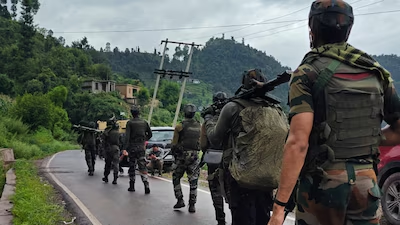Operation Shivshakti: Indian Army Foils Infiltration Bid in Poonch, Continues Crackdown on Cross-Border Terror
- MGMMTeam

- Jul 30
- 3 min read
In a decisive blow to Pakistan-backed terrorism, the Indian Army successfully carried out Operation Shivshakti in the early hours of July 30, 2025. The operation, conducted along the Line of Control (LoC) in the Degwar sector of Jammu and Kashmir's Poonch district, led to the elimination of two heavily armed terrorists. This action came just days after the conclusion of Operation Mahadev, signaling India’s sustained commitment to neutralizing terror threats at their roots.

A Swift and Coordinated Military Response
The operation began after Indian security forces received credible intelligence regarding a possible infiltration attempt across the LoC. The suspected movement was detected late at night in the Maldivalan area of the Degwar sector. Leveraging thermal imaging and ground-based surveillance, Indian troops quickly mobilized and launched an ambush in the dense forest terrain of the region.
What followed was a brief but intense exchange of fire. The army’s precise and timely action led to the killing of two infiltrators suspected to be operatives of the Pakistan-based terror outfit Lashkar-e-Taiba. A significant cache of weapons was recovered from the site. The area was soon cordoned off for a detailed search operation to rule out any additional threat.
Operation Shivshakti: The Strategic Context
Operation Shivshakti is part of a broader series of operations launched in the wake of the April 2025 Pahalgam terror attack, which left 26 civilians dead and shocked the nation. That gruesome attack triggered a massive response from Indian security forces, starting with Operation Sindoor and later Operation Mahadev, where three of the terrorists involved in the Pahalgam massacre were hunted down and killed in the forests of Dachigam near Srinagar.
These successive missions are not isolated events but reflect a deeply coordinated national counter-terrorism strategy. Operation Shivshakti fits into this continuum, illustrating the Indian Army's evolving approach—one marked by real-time intelligence sharing, swift deployment, and a zero-tolerance posture toward infiltration attempts.
The LoC and the Terror Transit Route
The LoC, particularly the Poonch and Rajouri sectors, has long been a favored route for Pakistan-sponsored terrorists attempting to cross into the Kashmir Valley. The geography of the region, especially areas like the Haji Pir bulge, makes it vulnerable to infiltration. Over the years, the Indian Army has carried out multiple anti-infiltration operations here, including the well-known Operation Sarp Vinash in 2003.
The Degwar–Maldivalan axis, where Operation Shivshakti took place, is one such sensitive point. Despite heavy fencing and monitoring, infiltrators often exploit gaps in surveillance during bad weather or use underground routes. The success of this operation, therefore, carries immense tactical significance. It not only eliminated an immediate threat but also sent a strong deterrent message to those attempting to breach India's sovereignty.
A Unified Security Architecture
One of the most remarkable aspects of Operation Shivshakti is the coordination between various wings of India’s security apparatus. Intelligence inputs were jointly developed by the Indian Army’s signals intelligence, ground operatives, and the Jammu & Kashmir Police. This inter-agency collaboration ensured that the infiltration attempt was detected early and neutralized before any harm could be done to civilians or infrastructure.
The White Knight Corps, under whose jurisdiction the operation was carried out, lauded the joint effort and emphasized that such synergy is now central to India’s anti-terror framework. Officials noted that continuous technological upgrades—like drones, motion sensors, and heat-detection cameras—are being integrated into surveillance efforts to further fortify the LoC.
Conclusion: A Clear Message to Terror Networks
Operation Shivshakti is more than just another tactical victory for India. It symbolizes a sustained policy of resilience, retaliation, and readiness. Coming on the heels of Operation Mahadev, it shows that India’s security forces are not only alert but increasingly proactive in addressing terror threats emanating from across the border.
The Poonch operation, though localized, carries national and even international significance. It reiterates India’s stand that terror and talks cannot go hand in hand. By continuing to dismantle terror networks through well-coordinated missions like Shivshakti, India is not only protecting its territorial integrity but also reclaiming psychological ground in the long-standing conflict over Kashmir.
As infiltration attempts continue to rise during the monsoon months, more operations are expected. But if Shivshakti is any indication, India is more prepared than ever to meet the challenge head-on—with clarity, courage, and conviction.
(Sources: Hindustan Times, OpIndia, News18)




Comments